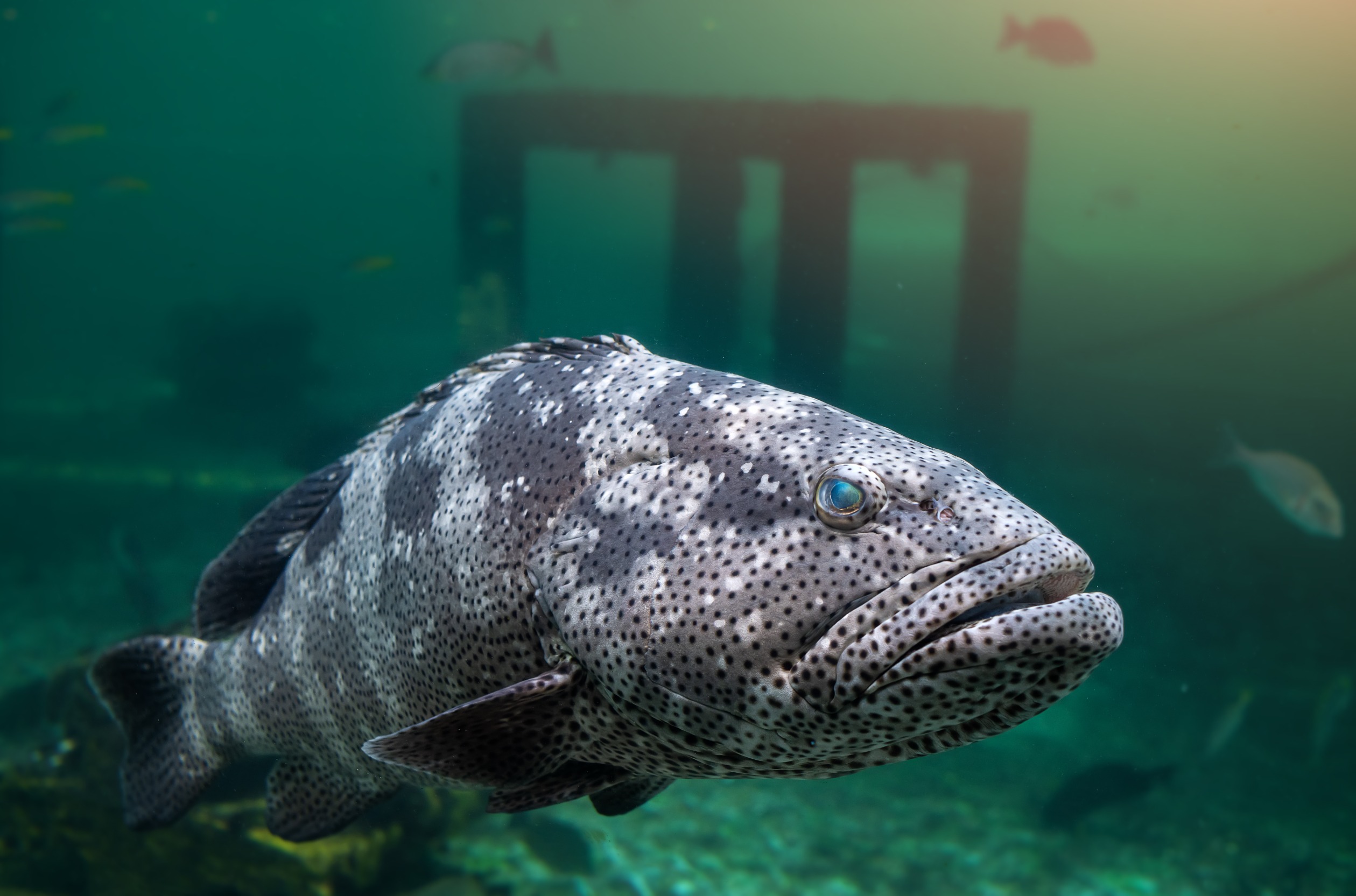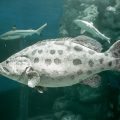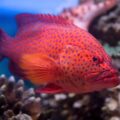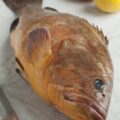The Epinephelus fuscoguttatus, popularly known as the Brown Marbled Grouper, is a fish species and member of the Serranidae family. It is found around the shores of Africa, the Indian Ocean, the Indo-Pacific region, and the Western Pacific Ocean.

Appearance
The Brown Marbled Grouper is a substantial fish that may reach lengths of up to 120 cm and weigh up to 25 kg. This species has a huge head, a wide mouth and a strong body that tapers toward the tail. Its prey is caught by sucking the prey in quickly and held in place until wholly consumed. The Brown Marbled Grouper’s body is covered in thick, rough scales that defend against predators and other dangers. The fish has a distinctive appearance because of the rows of scales, which are often rectangular. This species’ skin is rough to the touch and covered in a mucous coating as a barrier against parasites and abrasion.
Habitat
The Brown Marbled Grouper is a fish that lives among coral reefs and prefers sandy floors and rocky outcrops among other marine habitats. This species is frequently located in shallow waters, usually between 5 and 50 meters deep. Brown Marbled Grouper are in the waters of Southeast Asia, Australia, and the Pacific Islands, as well as the rest of the Indo-Pacific region. Additionally, it can be found in the Red Sea and around the African coasts, where fishermen and divers frequently come across it. In addition to rocky outcrops, coral heads, and crevices, the Brown Marbled Grouper prefers habitats with lots of cover. These habitats offer the fish a place to relax, hide, and be protected from predators while they wait for prey to approach.
Diet
The Brown Marbled Grouper feeds in a manner that is characteristic of most predatory fish, which ambush their food as they seek it. This species’ acute vision aids in its ability to identify probable prey. But it is often seen hidden amid rocks or coral layers, waiting for its prey to get close enough to be struck. The Brown Marbled Grouper will quickly lunge forward and seize its victim with its once it is within striking distance. It can grasp the prey securely and keep it in its mouth by sucking it in, and not by biting it with its teeth. This species is a fearsome predator in its habitat since it can consume food that is up to half its size.
Reproduction
Because the Brown Marbled Grouper is a protogynous hermaphrodite, it is born a female and eventually transitions to become a male. Environmental and social conditions, like variations in the water temperature or the lack of a dominant male in the colony, might cause this process to occur.
A male Brown Marbled Grouper develops a more pronounced head, darker coloring, and other notable physical changes. The fertilized eggs will subsequently be released into the water column once the male has courted and mated with a female.
Conservation Status
The International Union for Conservation of Nature classifies the Brown Marbled Grouper as Near Threatened. (IUCN). Being threatened is brought on by habitat loss, overfishing, and coral reef deterioration.
The Brown Marbled Grouper is a highly regarded food fish in many regions. It is also a well-liked species for recreational fishing. Overfishing and population loss are the results of this. Furthermore, the habitat of this species has been negatively impacted by the degradation of coral reefs brought on by climate change and human activity.
The Brown Marbled Grouper and other species connected to the reef are being protected. Fishing laws have been implemented in many nations to restrict the catch of this species, including minimum size restrictions and fishing seasons.
What are the Challenges and Opportunities of Sustainable Management of the Brown Marbled Grouper Fish?
Due to the Brown Marbled Grouper’s high value and market demand in the seafood industry, overfishing and population decline in the wild have occurred.
The ocean must be managed sustainably to assure the species’ continuous availability and preserve the natural balance of the marine environment. To address the Brown Marbled Grouper’s ecosystem sustainably, several obstacles must be overcome.
Challenges
Lack of effective regulation and enforcement
One of the main issues is the need for more effective control and enforcement of fishing techniques. Regulations and quotas for fishing are frequently not successfully enforced, which causes overfishing and illegal harvesting of the species. In addition to endangering the Brown Marbled Grouper population, this also impacts other marine life and the health of the marine environment.
Lack of accurate data
Another difficulty is the absence of precise information on the Brown Marbled Grouper’s population status. The creation of efficient management strategies depends on population assessments and monitoring procedures. But getting precise statistics can be challenging because of the species’ lateral agility and the size of the area it occupies. Setting suitable fishing quotas and creating sustainable management procedures requires accurate population data.
Climate Change
Climate change is a significant obstacle to the sustainable management of the Brown Marbled Grouper fishery. The ability of a species to reproduce and survive can be hampered by rising sea temperatures and the acidity of the oceans, which can result in population decreases. When creating management plans and adjusting to changing environmental circumstances, it is essential to take climate change’s effects on the ocean.
Lack of proper aquaculture practices
Because of the Brown Marbled Grouper’s modest growth rate and unique dietary needs, implementing sustainable aquaculture techniques might be difficult. It will need a lot of money and study to develop the species’ aquaculture methods that are sustainable and affordable.
Opportunities
The sustainable management of the Brown Marbled Grouper ecosystem opens up several benefits for both the fishing business and the environment. Here are some of the possibilities:
Economic Benefits
The Brown Marbled Grouper can benefit fishing communities by ensuring a continuous supply of fish for the seafood market. By using sustainable fishing practices, the species’ population can be kept healthy, ensuring a consistent supply of fish for commercial uses. Sustainable practices can provide fishermen revenue while supporting local economies that rely on the fishing sector. Furthermore, sustainable management approaches can improve the catch’s quality and worth, increasing income for fishermen and seafood processors.
Environmental Benefits
The sustainable management of the Brown Marbled Grouper has the potential to impact the entire marine ecosystem. Humans can help keep the Brown Marbled Grouper population healthy by decreasing overfishing and regulating fishing techniques. As a top predator, the Brown Marbled Grouper is very important in the food chain. Managing its population can prevent smaller fish’s overpopulation and their prey species’ depletion. By safeguarding the Brown Marbled Grouper, we can indirectly conserve other marine species and sustain the overall health and productivity of the marine ecosystem.
Research Opportunities
Sustainable management of the Brown Marbled Grouper fishery can also provide aquaculture research and innovation opportunities. Developing effective and sustainable aquaculture procedures for the species can aid in the reduction of pressure on wild populations. Apart from that, it can provide an alternate source of revenue for fishing communities while also improving the efficiency and profitability of the aquaculture industry. This research may also result in discoveries and developments in aquaculture, benefiting the fishing sector and the larger scientific community.
Improved Reputation
The fishing sector has a significant environmental impact, which must be prioritized for sustainable and ethical methods to maintain the long-term viability of their business and the marine ecosystem. Implementing sustainable fishing strategies such as selective fishing gear, avoiding overfishing, and limiting bycatch will help assure fish stocks’ long-term availability. Furthermore, certification organizations like the Marine Stewardship Council (MSC) can assist consumers in identifying and purchasing sustainably sourced seafood. The Brown Marbled Grouper is a highly appreciated species for its flavor and a popular fishing target. However, overfishing and habitat damage has resulted in a population reduction. The seafood sector may improve its reputation and attract consumers who value sustainability and ethical standards by establishing sustainable fishing practices and ensuring the continued availability of this species.
Collaboration Opportunities
Collaboration between fishing communities, government agencies, and other stakeholders is needed to sustain the Brown Marbled Grouper population. This collaboration has the potential to foster dialogue and relationships that benefit both the industry and the environment.
How to Reduce Fishing Pressure on the Brown Marbled Grouper Population
Reducing the fishing pressure on the Brown Marbled Grouper species is crucial for long-term management. Here are some techniques for reducing fishing pressure:
Implementing fishing quotas and size limits
Using fishing quotas and size limitations to lessen fishing pressure on the Brown Marbled Grouper population effectively reduces fishing strain. Fishing quotas can be determined based on population size and the viability of the fishery. These quotas limit the number of fish caught in a given period, preventing overfishing and allowing the species to regenerate. Size restrictions can also safeguard young fish and guarantee that only mature individuals are taken. Smaller and more immature individuals are safeguarded and given more time to grow and breed, which can help preserve the population over time.
Promoting sustainable fishing practices
Promoting sustainable fishing practices will undoubtedly aid in reducing the impact of fishing on the Brown Marbled Grouper population. Selective fishing gear and techniques, utilizing hooks rather than nets, using fish traps, and avoiding bottom trawling, may significantly decrease young or non-target species’ bycatch while minimizing damage to the marine ecosystem. Fishermen can use hooks to target specific kinds and sizes of fish, preventing the catching of immature and non-target species. Similarly, fish traps can be programmed to catch only the desired species while leaving other fish alone. However, using nets and bottom trawling, in contrast, can result in significant volumes of bycatch, such as unwanted fish and other marine life, which can be tossed back into the ocean, frequently dead or dying.
Establishing Marine Protected Areas (MPAs)
Forming marine protected areas, or MPAs is a popular method for reducing fishing pressure on the Brown Marbled Grouper species. MPAs can be established as “no-take zones,” which restrict fishing entirely. This can provide a haven for the Brown Marbled Grouper to grow and reproduce, increasing the number of individuals that can be sustainably fished outside the MPA over time. Furthermore, by maintaining vital habitats and decreasing human impacts, MPAs can assist in conserving the larger maritime ecosystem.
Supporting research and monitoring
Investing in research and monitoring can help reduce fishing pressure on the Brown Marbled Grouper species. Studying the species’ biology, behavior, and population trends allows management decisions to be informed and changed to guarantee the fishery’s long-term viability. Research can reveal insights into the species’ reproductive biology and life history, such as rate of development, maturity age, and breeding behavior. Data can inform guidance policies such as size limitations and restricted seasons, encouraging population reproduction and growth.
Developing alternative livelihoods
Creating different types of employment can also aid in diversifying local economies and building more resilient communities. For example, ecotourism or recreational fishing can provide money. In contrast, aquaculture can offer a different source of income for fishermen during non-fishing months or when fishing restrictions are in effect.
Conclusion
In conclusion, the Brown Marbled Grouper is a notable species of fish found in the Indo-Pacific region’s coral reefs. However, because of overfishing and damaging fishing techniques, its population has plummeted, and is now classified as a threatened species. We all must work together to safeguard this particular species and its natural surroundings since it not only helps to sustain fisheries but also adds to the general health and productivity of the marine ecosystem.











